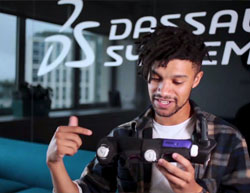How SOLIDWORKS Enabled Mitt Wearables
The loss or absence of a limb is a disability humans have been finding answers for since history began. From the ancient Greeks to the Egyptians, we’ve been inventing and refining stand-ins for lost limbs with varying degrees of success.
Comforting to know that in an era of virtual reality, artificial intelligence and robotic chefs, science is still finding new ways to make medical breakthroughs. It’s an ethos that Mitt Wearables has taken and woven into a successful business – and it’s had SOLIDWORKS for support since day one.
Who is Mitt Wearables?
A fledgling design company, Mitt Wearables make an incredibly effective prosthetic limbs. Prosthesis with ingenuity: interchangeable attachments, with the aim of a low entry price point and a simplicity that belies the diverse range of options on offer.
How do Mitt Wearables prosthetics work?
The bulk of existing prosthetics tend to err towards an inflexible rigidity. Hard, moulded plastic hands that ape the look, but not the functionality of human digits. It’s a lack of mobility that doesn’t lend itself naturally to the multitude of tasks human hands can master. So, in stepped Mitt Wearables to level the playing field.
Their patented design remoulds the prosthetic limbs to be worn as simply as a sleeve on a jumper. Wear the limb, then attach the tool you need. It keeps costs down and ensures the wearer can zero in on the specific task quickly and easily.
So, out with articulated hands, in with task-specific tools that snap easily into the limb’s cradle. Need to chop veg? Attach the kitchen blade. Want to play the drums? Attach a stick to your sleeve and play away. With easy off-the-rack size differences for the wearer, it’s an invention that users have hailed as comfortable, affordable and accessible.


How does SOLIDWORKS help?
Think of the sheer wealth of duties your hands perform in a single day. Now imagine what individual task-specific tools you might need for each one. That’s a lot of attachments. Mitt Wearables’ challenge is to design, craft and produce those attachments. Both time and labour-intensive, SOLIDWORKS’ 3D CAD was a gift to the design team behind those tools.
Having the core design loaded into the program meant that they could take their designs hot from the CAD and run them straight to 3D print, often inside the hour. A working prototype within minutes that makes it easy to see whether any design tweaks are required. It’s a time-saving strategy that cuts to the chase and crowbars more hours into the working day.
In addition Mitt Wearables were also helped along the way by being part of the esteemed SOLIDWORKS Entrepreneur Program.
What is the SOLIDWORKS Entrepreneur Program?
An initiative designed to enable new start-ups to turn their enterprising vision into a reality, the scheme gives young companies the opportunity to enjoy, for free, full membership to SOLIDWORKS and its technical support.
It meant Mitt Wearables could deliver the goods with SOLIDWORKS at the end of a phone or online support whenever they needed them. Having applied successfully to the scheme, it gave the assistive prosthetic company the kickstart to its ongoing attempt to create truly affordable and accessible products.
How’s that for a helping hand?
You may also be interested in:
>> Alita: Battle Angel inspires real world application of bionic arms
>> The engineering of Paralympian sports technology
>> Printing parts: how 3D printing has gone from gimmick to medical marvel




